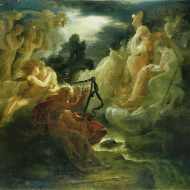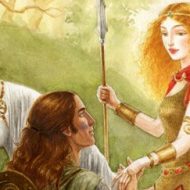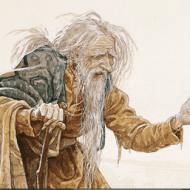Oisín : The Poet Who Bridged Worlds
Listen
At a glance
| Description | |
|---|---|
| Origin | Irish Mythology |
| Classification | Mortals |
| Family Members | Sadhbh (Mother), Fionn (Father), Niamh Chinn Oir (Wife), Oscar, Finn (Sons), Plor na Mban (Daughter) |
| Region | Ireland |
| Associated With | Poetry, Travelling, Longevity |
Oisin
Introduction
Oisín is one of the most celebrated figures in Irish mythology — a warrior-poet of the legendary Fianna and the eloquent voice through which many of their stories survived. His name, meaning “little deer” in Old Irish, connects him to the wild natural world that shaped much of Celtic imagination. As both poet and hero, Oisín bridges the physical and spiritual realms of ancient Ireland, representing the balance between strength and art, valor and reflection. His tale is deeply tied to themes of time, loss, and the fading of golden ages.
Oisín’s most famous story tells of his love for Niamh of the Golden Hair and their journey to Tír na nÓg — the Land of Eternal Youth. In this paradise, no one ages or dies, and Oisín lives in happiness for what seems like only a few years. When he finally returns to Ireland, centuries have passed. The Fianna are gone, and the land he knew has changed beyond recognition. The moment he steps down from his horse and touches the mortal soil, he instantly ages into a frail old man. This legend has made Oisín a timeless symbol of the cost of longing and the inevitable passing of eras.
Physical Traits
Descriptions of Oisín vary between sources, but he is often depicted as tall, noble, and strong — every inch the warrior his father, Fionn mac Cumhaill, raised him to be. Yet there is a gentleness in his demeanor, a calm wisdom that contrasts with the roughness of battle. Artists and poets through the centuries have portrayed him with flowing hair, carrying a harp or sword, embodying both grace and might.
When he returns from Tír na nÓg, his transformation from youthful hero to ancient wanderer is one of the most poignant images in Irish storytelling. It captures the fragility of human time compared to the eternal flow of myth. The symbolism of his name — “little deer” — also connects him to Celtic nature worship, agility, and purity. Oisín thus represents not just a man but a living embodiment of poetry’s eternal youth within a mortal frame.
Family
Oisín was the son of the great hero Fionn mac Cumhaill, leader of the Fianna, and Sadhbh, who was transformed into a deer by an evil druid’s curse. When Fionn saved her, she briefly regained human form, and Oisín was born. This origin explains his name and animal symbolism. Unfortunately, Sadhbh was later turned back into a deer and vanished, leaving Fionn to raise Oisín among warriors and hunters.
As an adult, Oisín fell in love with Niamh Cinn Óir, a radiant maiden from Tír na nÓg. She took him away on her magical white horse across the western sea to her eternal realm. Together they had children, including Oscar and Plúr na mBan. His family thus ties him to both worlds — the heroic human domain of Fionn and the divine, dreamlike land of the immortals.
Other Names
The name Oisín has appeared in several variations across Irish and international traditions. In English and Scottish literature, he is often known as Ossian, a form popularized by the 18th-century writer James Macpherson, who claimed to have translated ancient Gaelic poems about the hero. Although these “Ossianic” works were later revealed to be partly fabricated, they sparked a major cultural revival of Celtic identity across Europe. Other variants like Osian or Osheen preserve the phonetic sound of his name while adapting it for different languages and audiences. Despite these differences, all forms honor Oisín as the poet-voice of Ireland’s mythic past.
Powers and Abilities
Oisín’s powers come not from divine strength but from his mastery of words, memory, and endurance. As a warrior, he was said to possess unmatched courage and skill in combat, but his deeper gift was his ability to immortalize the deeds of his people through poetry. He became the chronicler of the Fianna, ensuring their bravery would never be forgotten.
During his time in Tír na nÓg, Oisín gained a form of supernatural longevity. The land’s magic preserved his youth and vitality, granting him an almost timeless existence. When he returned to mortal Ireland, his strength briefly remained superhuman — stories tell of him lifting enormous stones or performing feats no other man could. Yet this power faded the instant he lost contact with the fairy realm, emphasizing the impermanence of magic and the mortal cost of crossing between worlds.
Oisín’s greatest power, however, is his voice — a symbol of Irish bardic tradition itself. Through poetry, he transforms loss into beauty and memory into song, preserving his world long after its physical end.
Modern Day Influence
Oisín’s story has endured for centuries, influencing Irish literature, folklore, and nationalism. The 19th-century poet W. B. Yeats famously adapted his legend in The Wanderings of Oisin, using him as a symbol of Ireland’s spiritual heritage and the eternal struggle between art and duty. In this version, Oisín debates with Saint Patrick, representing the dialogue between the pagan past and Christian present — an allegory for Ireland’s cultural transformation.
His legend continues to inspire modern art, music, and film. Celtic musicians and storytellers often invoke Oisín in ballads about longing and love beyond time. Irish schools teach his story as part of national folklore, while tourist sites like “Oisín’s Grave” in County Antrim attract visitors curious about the hero’s resting place.
In contemporary discourse, Oisín represents more than myth; he stands as a cultural metaphor for memory and identity. He is the artist who remembers when others forget, the exile who sees the world age while he remains unchanged. For modern audiences, his tragedy resonates as a reflection on change — how progress, time, and modernity always come with loss.
Related Images
Source
BardMythologies.com. (n.d.). Oisín in Tír na nÓg. https://bardmythologies.com/oisin-in-tir-na-nog/
Ireland-Information.com. (n.d.). Oisín of the Land of Eternal Youth. https://www.ireland-information.com/irish-mythology/oisin-irish-legend.html
IrishCentral.com. (2021). Tír na nÓg: The legend of Niamh and Oisín. https://www.irishcentral.com/roots/history/tir-na-nog-legend-eternal-youth
Luminarium. (n.d.). Oisín in the Land of Youth. https://www.luminarium.org/mythology/ireland/oisinyouth.htm
Oxford Reference. (n.d.). Oisín. https://en.wikipedia.org/wiki/Ois%C3%ADn
Pitt.edu. (1999). Oisín in Tír na nÓg. https://sites.pitt.edu/~dash/oisin.html
StoryMuseum.org.uk. (n.d.). Oisín in Tír na nÓg. https://www.storymuseum.org.uk/1001-stories/oisin-in-tir-na-nog
Yeats, W. B. (1889). The Wanderings of Oisin and Other Poems. London: Kegan Paul, Trench & Co.
Frequently Asked Questions
What is the myth of Oisín?
The great Irish poet Oisn was the son of Finn, who was the leader of the Fianna, a warrior band in Celtic mythology. The main story about him is about his journey to the mythical realm of eternal youth. He met a fairy woman named Niamh Chinnir, who was one of the daughters of the sea god Manannn Mac Lir.
What does Oisín mean?
Oisn means “little deer” or “fawn.” The name was derived from the Old English word “deer” + “n,” which literally means “diminutive.”
Is the name Oisín male or female?
Oisín is a male given name in Irish culture.
Was Oisín a warrior?
Yes, Oisín was a great warrior poet and the son of Finn, leader of a warrior band known as the Fianna in Celtic mythology









